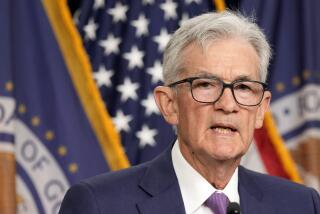Fed may keep short-term rates low long after bond-buying pullback
WASHINGTON — Federal Reserve policymakers, expecting to pull back on their bond-buying stimulus “in coming months,” are considering keeping short-term interest rates quite low for quite a while, among other options to try to support what they see as a moderately improving economy.
Financial markets have been intensely anticipating signs for when the Fed might start reducing its $85-billion-a-month purchase of Treasury and mortgage securities, a program aimed at holding down long-term interest rates.
But minutes of the central bank’s policy meeting last month, released Wednesday with the customary three-week lag, offered no additional hint of how soon that might come.
There’s an outside chance that Fed officials could decide to reduce the central bank’s bond-buying program at the next meeting set for Dec. 17-18. But analysts generally think policymakers will wait until January or March before making any such move, wanting to see further signs of a strengthening economy and job market.
On the whole, economic data since the Fed’s Oct. 29-30 meeting have been somewhat brighter. Payroll-job gains were surprisingly strong in October, despite the partial federal government shutdown and budget standoff in Washington, which Fed officials regarded as “temporary and limited” in terms of any direct effect on the economy, according to the minutes.
The economy overall grew at a faster-than-expected 2.8% annual rate in the third quarter. However, growth this quarter is looking considerably weaker, expected to be in the neighborhood of 1.5%, and the crucial housing market has lost some steam since mortgage rates rose in the summer.
Still, Fed policymakers are ready to dial back the bond purchases. The 100-year-old central bank has never taken on such a hefty amount of assets now in its books, and officials aren’t sure that the stimulus is having the bang for the buck that it did earlier.
That growing discomfort was evident in Fed Chairman Ben S. Bernanke’s speech Tuesday night, when he spoke of the “uncertainty about the costs and efficacy” of large-scale bond purchases.
The problem is that Bernanke and his colleagues worry that a pullback of this unconventional stimulus will stall markets and the broader economy.
Comments by Bernanke last spring that mentioned the possibility of an imminent tapering of bond-buying dragged down financial markets and sent long-term interest rates surging, which many analysts view as a major factor in the housing slowdown since summer.
“The Fed doesn’t want to see any more volatility in interest rates or rise in long-term rates,” said James Marple, a senior economist at TD Economics, part of the TD Bank Group. “It would like to make the transition out of asset purchases as smooth as possible, and it doesn’t know exactly how to do that.”
“How do you taper without scaring the market?” he asked.
In recent months Fed officials have sought to make clear that a withdrawal of bond-buying activity doesn’t mean monetary conditions are tightening. And at their last policy meeting in October, Fed officials discussed ways to reinforce the thinking to markets that the short-term rate, the so-called federal funds rate, could remain unusually low even after it has moved off the bottom. By keeping that target rate low, the Fed would help hold down borrowing costs for businesses and consumers.
In his speech Tuesday night at the National Economists Club in Washington, Bernanke said that “we have seen meaningful improvement in the labor market” since the bond-buying stimulus began in September 2012. And he said Fed officials expect to see continued improvement in the job situation and the inflation rate moving toward the central bank’s 2% target — preconditions for an imminent reduction of bond purchases.
Bernanke, though, took pains to note that the federal funds rate was a separate matter. He said that “even after unemployment drops below 61/2%, and so long as inflation remains well behaved, the [Fed] committee can be patient in seeking assurance that the labor market is sufficiently strong before considering any increase in its target for the federal funds rate.”
More to Read
Inside the business of entertainment
The Wide Shot brings you news, analysis and insights on everything from streaming wars to production — and what it all means for the future.
You may occasionally receive promotional content from the Los Angeles Times.











